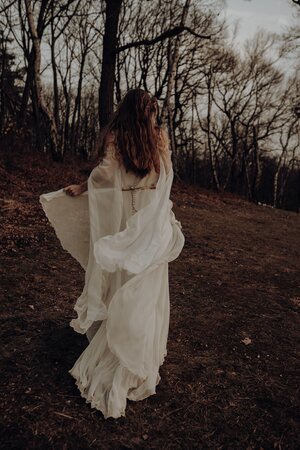Have you ever felt like your witchcraft wasn’t good enough because it wasn’t traditional enough? Or maybe you feel you need some kind of lineage to give your craft validity. This is a very common line of thinking among modern witches and it’s easy to see where these ideas come from. There is no shortage of holier-than-thou, I’m the most traditional witches out there brandishing on their soapboxes about the evils of modern witchcraft and how the traditional craft. In their eyes, the “real” craft, is being watered down and lost by modern witches.

It’s easy to get sucked in by these lines of thinking, after all, they’re the ones with the history and the tradition to speak from! I’ve never taken to these ideas though. While it’s easy to get caught up in the idea that older equals better and more powerful, I’ve never seen evidence of this in practice. As you all know, I am all about results. If the magic works and it gets you actual results in your life, then it’s good magic! That said, I also don’t discount the value of the traditional in our modern witchcraft. Today we’re going to be discussing the value of both traditional and modern witchcraft and how you can have the best of both worlds in your personal practice.
Is Traditional Better Than Modern Witchcraft?
First things first, traditional witchcraft is not necessarily any better than modern witchcraft. The traditionalists out there will skewer me for saying it but it’s true. There’s nothing inherently more magical about the way we did magic 200 years ago versus how we do magic today. Magic is magic is magic. If it gets results, it gets results.
One of the big problems with this argument is that “traditional” and “modern” are rather vague terms. I mean, what exactly is traditional witchcraft? Is there a standard definition for modern witchcraft? These terms really just describe how long we’ve been using specific practices. For example, flying ointment has been used for several hundred years and thus is considered traditional witchcraft. Tech witchcraft is a very recent addition to the magical world and so it is modern witchcraft. This is the only real difference between the two. The reality is that at all points in history people have made magic with whatever is available to them. Before the technological age, witches used what they had available which would have been plants, animals, stones, etc. Today we have smartphones, laptops, modern manufacturing, and all kinds of things that our ancestors couldn’t have even dreamed of.
On top of this, traditional witchcraft means something different depending on where you are. This is a very location-dependent term. Traditional witchcraft in the Northeast of the United States means something different from traditional witchcraft in the southern United States, which means something different from traditional witchcraft in Italy, which means something different from traditional witchcraft in Mexico. So when proponents of traditional witchcraft are pushing their preferred tradition, they are actually pushing to spread a variety of magic that is intrinsically bound to the land that it is a part of. It is very difficult if not impossible to practice something like traditional Cornish magic if you are in, say, Texas.
The argument that traditional magic is inherently better than modern magic falls apart under the weight of its own assumptions because there is no such thing as a unified tradition of magic. When we talk about traditional magic, we’re discussing an incredible breadth of magical practices, regions, and spiritual beliefs. And we’re expected to believe that ALL of these are somehow inherently better than anything we’ve created in the modern world? I just don’t see the logic there.
Why People Want “Traditional” Witchcraft
This begs the question then, why do people get so hung up on the idea of needing traditional witchcraft? The answer is fairly simple. Many of us struggle with feelings of inadequacy or imposter syndrome. What we do as witches is very counter to mainstream spirituality. It is not easy to go against what you have been taught your entire life and what the rest of the world considers “real” to do what you feel intuitively is right for you on a spiritual level. It’s scary! A lot of us spend the first years of our journey into witchcraft wondering if we’re just plain nuts. It feels like we might be making it all up in our heads and we want something that helps us to feel like we’re on solid ground again.
This is what tradition represents for a lot of people. When relying on your intuition and your own spiritual guidance starts to feel unreliable, we want to create a sense of continuity, community, and stability to avoid those feelings. Traditional forms of magic feel much more stable and valid simply because of the history involved in the creation of that magic. It essentially gives you a community of people who have vetted and created this form of magic for you. This is not necessarily a bad thing, we want magic that works! But when you allow those urges to dictate your magical practice, it can lead you astray. Believing that you absolutely must have this external validation and history to be a real witch robs you of your power and your intuitive connection to your magic. Why are you any less capable of creating and pioneering real magic than the people who came before you? The answer is that you’re not. You have simply been taught to distrust your intuition and distrust your sovereignty as a spiritual being. This is nothing more than Western Christian-centric thinking that has taught us for our entire lives that we are lesser spiritual beings and must get our knowledge of the divine and the spiritual from an outside source. It is not true.
There is nothing wrong with looking to external sources for spiritual guidance, but when you begin to take those external sources as ultimate truths and you stop allowing your inner guidance to speak to you, you relinquish one of your greatest powers as a witch. You give up your ability to choose a spiritual path for yourself.
It’s Up To You!
Don’t get me wrong, there is nothing inherently wrong or limiting about traditional witchcraft. The problem occurs when we become dogmatic about our adherence to the traditional over modern forms of magic. Dogmatism in any form leads to constriction in our choices, our freedom, and our power. The reality is that I want you to take anything that you find useful from traditional witchcraft and modern witchcraft. This is the real beauty of the technological age that we live in. You have the ability to craft a unique spiritual path for yourself that leads exactly where you want to go and changes your life in exactly the ways that you want it to change. This is what I’m all about!
It’s up to you how much traditional magic you use and it’s up to you how much modern magic you use. Blending these two together takes time and an exploratory mindset but it can be very fun and incredibly rewarding to build a craft that is entirely yours.
How To Blend The Traditional With The Modern
So, how do we go about blending traditional witchcraft with modern witchcraft in truly practical ways? The answer to this question will be very different from person to person, but the suggestions below should help get you started.
1. Research the traditional uses of the native materials in your location
As I said before, traditional magic is very much location-based. When you are looking to incorporate traditional magic into your practice, you want to focus on the traditions associated with your location, i.e. where you live, and potentially also the traditions associated with your heritage. My favorite way to begin doing this is to go for nature walks and to collect samples of or information about the plants, stones, animals, and other natural features of the environment that I live in. You can even do this if you live in a city. Even places like New York City have natural and native plants and wildlife hidden in plain sight. When you’ve learned about the kinds of things that grow and live in your environment, start to research what the traditions of magic in your local environment would have used these materials for.
If you live somewhere like the US, do keep in mind that you might live in an area where the only tradition of magic that exists is native and thus closed. If this is the case, please do not steal from them. Cultural appropriation is completely unnecessary given the vast array of magical knowledge available for us to use. Why go out of your way to steal something that we have been asked not to touch when there is a mountain of magic being given away freely?
That said, there are a ton of magical traditions in the United States that are not closed so don’t be afraid to look and see what is available in your area. The Northeast, the South, the Appalachians, and even the Pacific Coast all have open traditions of magic. You might be very surprised at the magical traditions hiding in your own hometown!
The point is, most traditional magic is at least somewhat animistic and they tended to be very deeply connected to the land that they worked with. By researching and adopting how these traditions interacted with the land that you live on, you can develop a much deeper connection with your home and with the materials that you use in your magical practice.
2. Incorporate modern magical techniques and tools
Start looking into magical techniques that are decidedly modern. You do not have to use every single modern magical technique that you find, but as you begin to research, you may find some forms of modern magic really appeal to you. For example, you may love the idea of using your computer to create digital altars or vision boards to cast spells. Or you might find a modern school of magic like chaos magic and incorporate some of their ideas and practices into your craft. Even the law of attraction is a very modern addition to witchcraft.
The fact of the matter is, we are modern people living in a modern world. There is no reason for us to recreate the exact magic done by people who lived in a very different world. You have some incredible technology, ideas, and practices available to you as a modern witch and you should take advantage of those resources in whatever way suits you. Don’t let anyone tell you that your tech magic isn’t real magic or that modern computers and machinery are somehow spiritually defunct. Your smartphone has an energy and a spiritual function just like every other part of our world!
You do not need to give up the things that make you who you are to try to fit into some arbitrary definition of traditional magic. What are you most connected to in your day-to-day life? What lights you up? Look at how the modern world has impacted those areas of your life. How can you incorporate magic into the more modern parts of your world? Can you start to see and feel the spiritual in the modern and the mundane? I promise you, it’s there, you just have to learn to look for it.
3. What did the traditional magic in your region look like?
We discussed looking into the local magical traditions of your home to learn more about the land, plants, and materials you might work with in a more traditional setting but the traditional magic of your region or your heritage has a lot more to offer than just correspondences. Magical practices vary wildly around the globe. I would encourage you to look into the kinds of magic, the actual practices used by the traditions that you are connected to. For example, in the south, Hoodoo makes use of graveyard magic and playing card magic. Appalachian Granny magic uses water, dousing, folk medicine, and alcohol as primary methods of casting magic. New England traditional witchcraft would look very similar to some forms of European witchcraft, utilizing things like witch’s ladders, poppets, and working with spirits like the Witch Father and familiars.
Each tradition has a set of practices, tools, spells, and rituals that make up the bulk of the tradition. By looking into how the people in your local environment would have done magic, you can learn a lot about the land you live on, the lives these people led, and the kinds of magic that they were prone to. You’ll be able to pull the practices that are relevant to your life into your craft while leaving the less than useful spells for blighting your neighbor’s cows in the past.
This is really what combining the traditional with the modern is all about. As much as the allure of traditional witchcraft can be tempting, we are living in a modern world. We have modern needs and modern resources and by picking and choosing what we keep from traditional forms of witchcraft and combining them with the modern forms of witchcraft that work for us, we’re able to create a form of magic that is entirely personal to us and what we need in our lives. You shouldn’t have to practice some cookie-cutter version of witchcraft that doesn’t take you as an individual and a modern witch into account. You need witchcraft that is responsive, in tune with your real needs, and tailored to you personally. Don’t let anyone tell you that the way you craft your practice and the way you use magic to improve your life is wrong. As long as it’s right for you and it gets results in your life, your practice is valid.
New to witchcraft?
Sign up for my FREE Witchcraft class!



